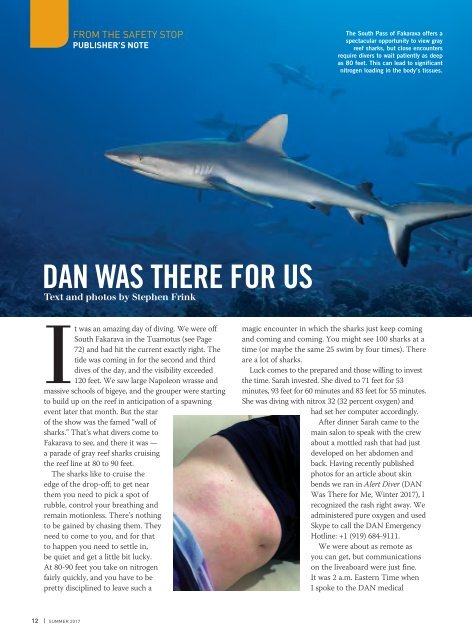AD 2017 Q3
Alert Diver is the dive industry’s leading publication. Featuring DAN’s core content of dive safety, research, education and medical information, each issue is a must-read reference, archived and shared by passionate scuba enthusiasts. In addition, Alert Diver showcases fascinating dive destinations and marine environmental topics through images from the world’s greatest underwater photographers and stories from the most experienced and eloquent dive journalists in the business.
Alert Diver is the dive industry’s leading publication. Featuring DAN’s core content of dive safety, research, education and medical information, each issue is a must-read reference, archived and shared by passionate scuba enthusiasts. In addition, Alert Diver showcases fascinating dive destinations and marine environmental topics through images from the world’s greatest underwater photographers and stories from the most experienced and eloquent dive journalists in the business.
Create successful ePaper yourself
Turn your PDF publications into a flip-book with our unique Google optimized e-Paper software.
FROM THE SAFETY STOP<br />
PUBLISHER’S NOTE<br />
The South Pass of Fakarava offers a<br />
spectacular opportunity to view gray<br />
reef sharks, but close encounters<br />
require divers to wait patiently as deep<br />
as 80 feet. This can lead to significant<br />
nitrogen loading in the body’s tissues.<br />
DAN WAS THERE FOR US<br />
Text and photos by Stephen Frink<br />
It was an amazing day of diving. We were off<br />
South Fakarava in the Tuamotus (see Page<br />
72) and had hit the current exactly right. The<br />
tide was coming in for the second and third<br />
dives of the day, and the visibility exceeded<br />
120 feet. We saw large Napoleon wrasse and<br />
massive schools of bigeye, and the grouper were starting<br />
to build up on the reef in anticipation of a spawning<br />
event later that month. But the star<br />
of the show was the famed “wall of<br />
sharks.” That’s what divers come to<br />
Fakarava to see, and there it was —<br />
a parade of gray reef sharks cruising<br />
the reef line at 80 to 90 feet.<br />
The sharks like to cruise the<br />
edge of the drop-off; to get near<br />
them you need to pick a spot of<br />
rubble, control your breathing and<br />
remain motionless. There’s nothing<br />
to be gained by chasing them. They<br />
need to come to you, and for that<br />
to happen you need to settle in,<br />
be quiet and get a little bit lucky.<br />
At 80-90 feet you take on nitrogen<br />
fairly quickly, and you have to be<br />
pretty disciplined to leave such a<br />
magic encounter in which the sharks just keep coming<br />
and coming and coming. You might see 100 sharks at a<br />
time (or maybe the same 25 swim by four times). There<br />
are a lot of sharks.<br />
Luck comes to the prepared and those willing to invest<br />
the time. Sarah invested. She dived to 71 feet for 53<br />
minutes, 93 feet for 60 minutes and 83 feet for 55 minutes.<br />
She was diving with nitrox 32 (32 percent oxygen) and<br />
had set her computer accordingly.<br />
After dinner Sarah came to the<br />
main salon to speak with the crew<br />
about a mottled rash that had just<br />
developed on her abdomen and<br />
back. Having recently published<br />
photos for an article about skin<br />
bends we ran in Alert Diver (DAN<br />
Was There for Me, Winter <strong>2017</strong>), I<br />
recognized the rash right away. We<br />
administered pure oxygen and used<br />
Skype to call the DAN Emergency<br />
Hotline: +1 (919) 684-9111.<br />
We were about as remote as<br />
you can get, but communications<br />
on the liveaboard were just fine.<br />
It was 2 a.m. Eastern Time when<br />
I spoke to the DAN medical<br />
12 | SUMMER <strong>2017</strong>









